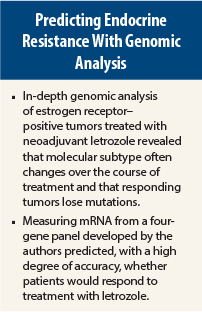At the 2014 San Antonio Breast Cancer Symposium, a research team led by Michael Dixon, MD, of Western General Hospital in Edinburgh, shed light on the development of endocrine resistance and presented a four-gene messenger RNA (mRNA) profile that can predict response to letrozole with a high degree of accuracy.1
Mutations in certain genes have previously been shown to confer resistance to aromatase inhibitors, and certain molecular subtypes—especially luminal B and HER2-enriched—have been associated with poor outcomes. To improve outcomes for patients who become resistant to endocrine therapies, it would be helpful to identify key mutations and how they interact with molecular subtypes. The dynamic profiling of the same tumor, at baseline and throughout neoadjuvant endocrine therapy, could be a unique opportunity to identify important genomic changes, Dr. Dixon pointed out.
“What we need is a better test to predict who will respond to endocrine therapy and to help us better understand endocrine resistance,” Dr. Dixon said. He believes their research may have accomplished just this.
Dr. Dixon and his team evaluated postmenopausal women with estrogen receptor–rich tumors treated with neoadjuvant letrozole, including 73 from Edinburgh and 44 from the Royal Marsden Hospital in London. Fresh tissue taken at baseline and at 14 days was used to develop a predictive test based on mRNA expression. To understand endocrine resistance, they evaluated 17 patients, a cohort enriched for nonresponse, who had multiple biopsies at baseline, 14 days, and 6 months to 3 years.
Serial sampling meant that tumors were evaluated while sensitive to endocrine therapy and upon de novo or acquired resistance to it. This gives a dynamic picture of how the genetic makeup changes as resistance develops, Dr. Dixon explained.
Key Findings
Based on what the researchers observed on the molecular profiling of serial biopsies, they reached these conclusions:
- Molecular subtypes change according to response to treatment: nonresponders are more likely to be luminal B at the start or to end treatment with luminal B status; responders are more likely to be luminal A at the start or to become luminal A.
- Responders demonstrate a loss of genetic mutations.
- New mutations develop in nonresponding tumors; these changes suggest that clonal selection is occurring.
- Baseline analysis is insufficient to predict response to endocrine therapy.
- A four-gene model can predict response to letrozole with accuracy.
Study Details
Of the 17 patients, 13 progressed on treatment or initially responded and then developed resistance, whereas 4 patients responded well. Their dynamic clinical response was assessed via three-dimensional ultrasound measurements obtained during treatment. Fresh tissue was taken before treatment and after resistance developed. RNA and DNA were extracted from the tumor, and normal DNA was obtained from matched blood or normal lymphatic tissue. The researchers used UNCeqR, which integrates RNA and DNA sequencing, to improve mutation detection. This technology is particularly valuable if there is low tumor cellularity or a low variant allele fraction of mutations.
The intrinsic subtype results across time showed that some luminal B tumors at baseline became luminal A by the time of the last biopsy, whereas some “hopped” from luminal A to luminal B and back to luminal A, depending on the status of response.
“We saw that nonresponders were much more heterogeneous than responders, but there was a tendency to maintain their luminal B status, although some luminal Bs did change to luminal A,” he said.
There were 12 patients with multiple samples and normal DNA, based on UNCeqR analysis. Somatic mutations were comparable to those found by the Cancer Genome Atlas, although some genes were mutated more frequently than expected. Only two “passed the test” of being significant on multiple tests: GATA3 (a transcriptional factor in luminal epithelial differentiation) and SMCP (sperm mitochondria-associated cysteine-rich protein).
Counting the mutations in the tumor, and associating them with response status, the researchers observed that responders had a high level of mutations at baseline that “appeared to fall dramatically” with treatment. Nonresponders did not demonstrate an obvious pattern. This loss of mutation was not explained by changes in tumor cellularity, he added. Genetic heat maps of the resistant patients showed that mutations remain present throughout treatment, although their composition and allele frequency change over time.
Four-Gene Model
Dr. Dixon and his team determined that measuring mRNA from four genes could predict response to letrozole: two of which were measured at diagnosis and two proliferation genes that were measured on day 14 of treatment. At baseline, mRNA levels of IL6ST, which functions as a transmembrane signal transducer, and mRNA from NGFRAP, which is thought to be involved in apoptosis, predicted response. At day 14, mRNA from MCM4, which is essential for eukaryotic genome replication, and ASPM, which is involved in mitotic spindle function, were predictive.
Although the concept has been that “apoptosis is important after treatment,” he said the study shows that “apoptotic genes at diagnosis matter as to whether the cancer will be responsive to letrozole.”
He added, “Potentially, at 14 days, the mRNA levels of these proliferation genes predict outcome. Unless letrozole ‘switches off’ proliferation, you don’t appear to get the benefit in the long run from endocrine therapy. In responding tumors, once proliferation ‘switches off,’ it stays off.”
With the application of mRNA from this four-gene profile, he said, “Every patient gets an indication of mRNA whether she will respond or not respond.”
The test was highly accurate, both the training set of 73 tumors (96%) and the validation set of 44 (93%). Its application to the 17-patient cohort enriched for poor response showed it to be 100% accurate in predicting patients who achieved a “quick stable response,” those who were “static then progressed,” and those who “progressed.” It was 83% accurate in predicting which patients would respond and then progress, missing only one of these six patients.
“In our 17 patients, we could detect at 14 days who would not do well. We only got one wrong,” he said. “This test appears to have clinical utility.”
Dr. Dixon said this research shows that “baseline analysis is not sufficient to predict response to endocrine or any other treatment. We need to analyze the cancer during treatment, because it will change.” ■
Disclosure: Dr. Dixon reported no potential conflicts of interest.
Reference
1. Dixon JM, Turnbull AK, Fan C, et al: In-depth genomic analysis of ER+ breast cancers during development of endocrine resistance. 2014 San Antonio Breast Cancer Symposium. Abstract S1-05. Presented December 10, 2014.



